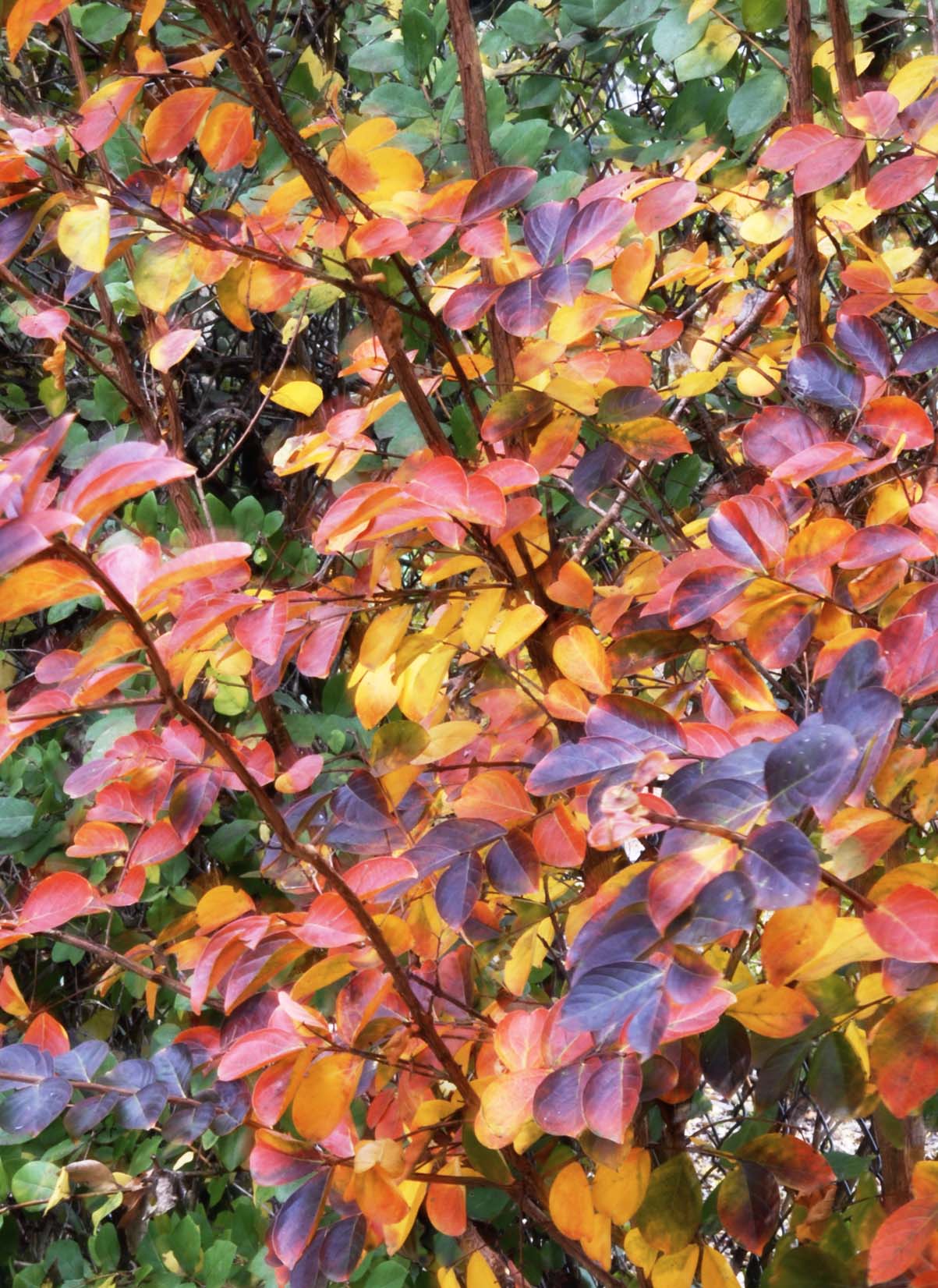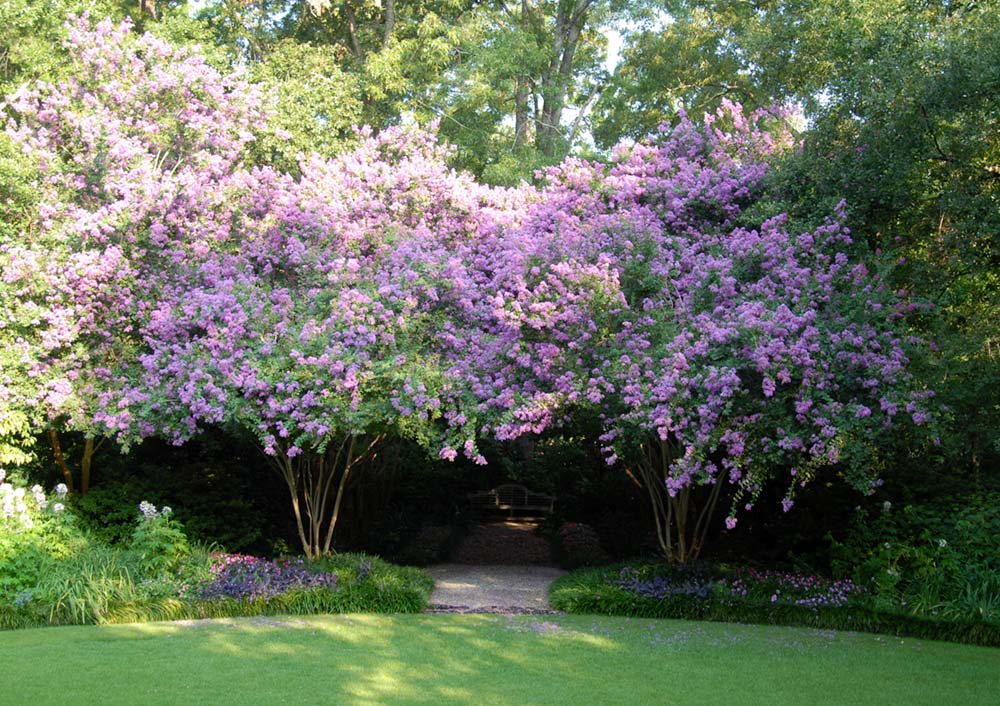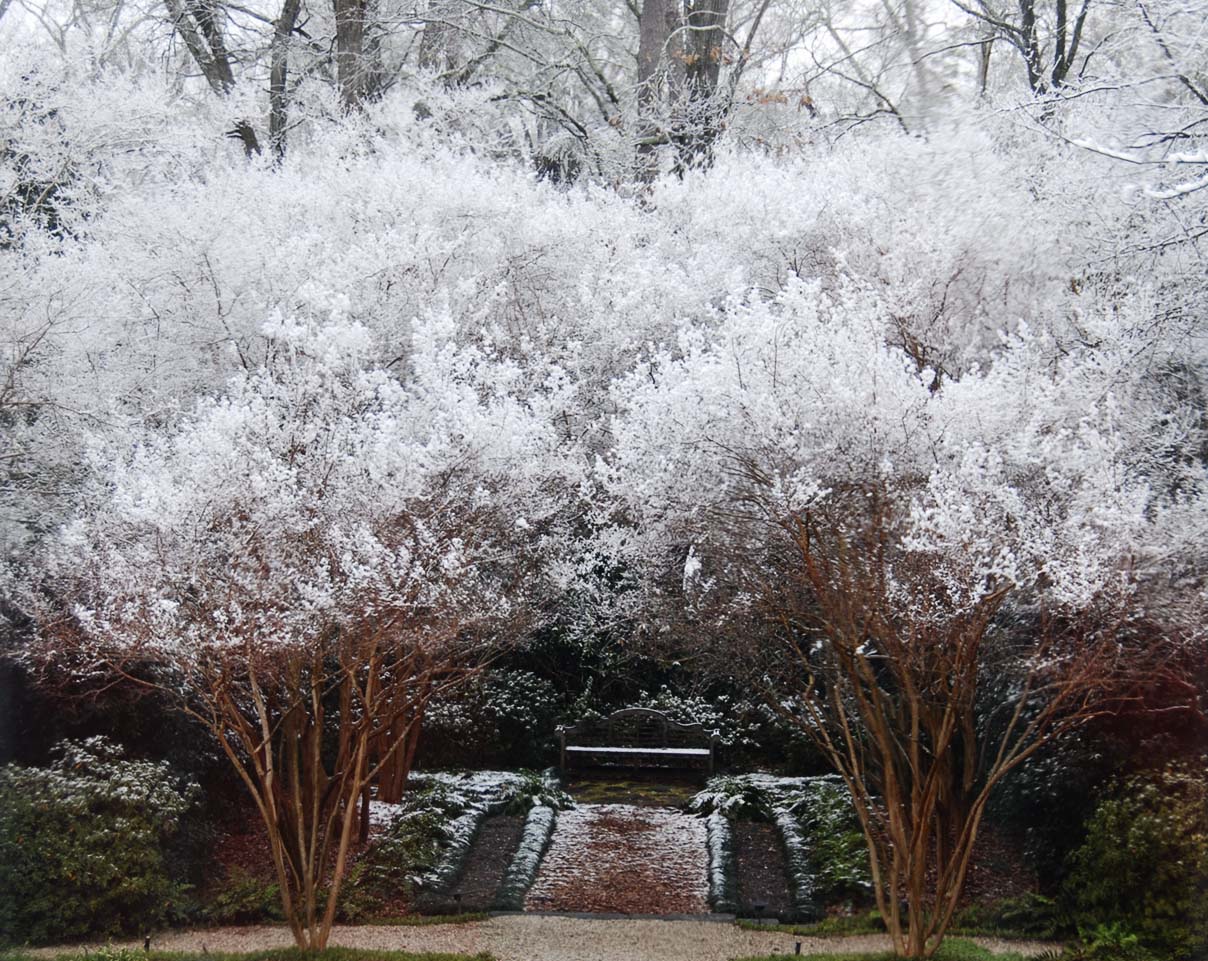
An inviting allée of properly pruned crepe myrtle trees in the author's backyard
JAMES BOND & ME IN THE GARDEN
The night erupts in enemy fire. Blue eyes blazing, James Bond turns to me and says, “I must reach that allée of crepe myrtle trees before the Russians destroy them.”
“I’m coming with you,” I declare.
“No!” the clipped British accent says. “Too dangerous.”
I grab his arm. “But the only way to save them is to cut their branches. Do you know how to prune crepe myrtle trees?” I demand. “I do.”
The hero capitulates. “Let’s go!”
This morning I’m working in the garden while imagining a thrilling scene from the movie last night—except I’ve replaced the gorgeous nuclear scientist who defuses the bomb and revised the plot a bit. I smile as I recognize in my mild-mannered breast the fleeting desire to be the one who summons her expertise and courage to save the world. Doubtless this impulse stirs every human heart, and that’s one reason James Bond is so popular. But why crepe myrtle trees? you may be asking.

When it comes to pruning these ornamental trees, much is at stake.
In the midst of my daydream, my gardener and I have been pruning the crepe myrtle allée in my garden, and I have been pondering this question: what expertise do I possess that in a difficult situation I could step into the breach and say with confidence, “I’ll do it.”
As I work, I realize I know how to perform a valuable skill: I know how to prune crepe myrtle trees. Between the dizzying fiction of a James Bond movie and the pedestrian dimensions of our own lives, it is important to recognize the difference. But it’s also important to appreciate the expertise we do possess.
SAVING THE WORLD, ONE CREPE MYRTLE AT A TIME
Those who love the crepe myrtle will forgive this horticultural hyperbole because everywhere we see crimes of pruning committed against these trees. The crepe myrtle—the premiere ornamental tree of the South—is without equal in year-round seasonal interest. In spring, the leaf buds swell red, creating a light maroon wash across the canopy; in summer, the lavish blooms stop you in your tracks; in late summer, the fallen petals spread before you like jewels scattered on the ground; in autumn, many varieties boast glowing orange-gold or red foliage; and in winter, the sculptural form of the trunks shines in the sun like pulled taffy.

Sculptural trunks offer year-round interest.

A crepe myrtle shows off its autumn colors.
But the saddest sight of all is to see the barbaric way ignorant people prune these trees. They saw them off at chest-height. It’s like taking a chainsaw to the Venus de Milo and sawing her off at five feet. I use the simile on purpose because the shape of a crepe myrtle tree is one of the most beautiful sculptural forms in the garden.
When properly trained, a multi-stem crepe myrtle tree is a three-dimensional delight of form, sunlight, and shadow.

Another view of the author's crepe myrtle allée
Years ago, when I was designing my first big residential landscape project, I needed a focal point for a large curvilinear lawn. I wanted the most beautiful thing I could think of. I chose a small, on-grade, elliptical-shaped deck in an intimate grove of six mature crepe myrtle trees. We found those trees in the country and relocated them with a tree spade. And what a success: it was magical to sit on the deck, sequestered within that screen of sinuous trunks, sheltered beneath their luscious blossoms.
To be sheltered by crepe myrtle trees is a very special garden experience. For this reason, I created an allée of crepe myrtle trees for my own garden. For fifteen years, we have been pruning these trees, carefully shaping them every year to create the vision of a sculptural screen bordering the walk and arching overhead, a seductive tunnel of branches and bloom.
How do you do it? I’ll tell you.

In spring, the leaf buds swell red, creating a light maroon wash across the canopy.
PRUNE CREPE MYRTLE TREES LIKE AN EXPERT
BEGIN AT THE BEGINNING
vAt the nursery select shapely, multi-stemmed trees. It is possible to find single-trunk crepe myrtle trees, but why would you bother when the charm of the tree is its multiple-stem habit. The size of the tree depends on your budget. But large or small, choose trees that have between three to five, possibly six, satisfactory main trunks. These are the trunks you will nurture over the years, pruning away any other weak stems that grow from the ground or low branches that grow out from the trunks. As the tree grows, continue to limb it up, meaning snip off the lower lateral branches so that the tree gradually lifts its crown over your head. Keep in mind your ultimate vision for the shape of the tree, pruning away lateral branches that don’t conform. Don’t allow the tree to waste your time and its energy growing in a direction you don’t want.
SELECT THE RIGHT TOOL
The pruning tool you need will depend on the size of the cut required and its height above the ground.
- Hand pruners generally cut up to a ¾-inch-diameter branch.
- Depending on the model, loppers cut up to a 1 ½-inch-diameter or larger branch. Turn the thin blade closest to the trunk so you make a clean, smooth cut against the trunk.
- To cut off a big, heavy branch, use a hand saw, but do not begin by trying to saw the big branch off flush with the trunk. If you do, the weight of the big branch as it falls will strip bark off the trunk of the tree before you can complete the cut. To avoid this disaster, use the three-step pruning technique below.
3-STEP PRUNING TECHNIQUE FOR LARGE, HEAVY BRANCHES
- About 1 ½ feet out from the trunk, make the first cut from underneath the branch, sawing up halfway through the branch.
- Then go a foot further out along the branch and cut all the way through the branch from the top.
- Finally, prune off the 2 ½-foot branch stub, making a cut flush with the trunk. If you can’t reach the cuts you want to make, use a pole pruner.
WHAT TO PRUNE
Over time, prune out thin, spindly branches in the crown of the tree. Prune out branches that cross each other and rub together. Prune out dead branches. If you’re making an arch with two or more trees, prune out the branches that detract from the arch. This careful method will reward you richly over the years. If you have a large, overgrown crepe myrtle that has never been shaped, these same guidelines apply.
THE CARDINAL RULE
Never ever saw off the trunks straight across in the mistaken idea it will make the tree bloom better. The shape of the tree will be ruined. It will continue to grow, sending out a spray of thin shoots of branches in every direction, but the sculptural shape will be lost forever.
James Bond, take note.

Snow on a canopy of well-pruned crepe myrtle trees sets a majestic scene.
Text and photography Mary Walton Upchurch © 2020
Garden writer Mary Walton Upchurch grew up in Montgomery, Alabama, and earned a degree in landscape architecture from the Harvard Graduate School of Design. For more than 30 years, she practiced in Montgomery as an award-winning landscape architect and wrote garden articles for a local publication. Now retired, she lives in western North Carolina where she built a home and garden on top of a mountain with panoramic views of the Blue Ridge Mountains.




